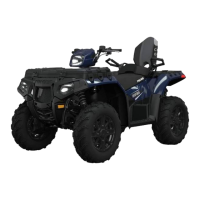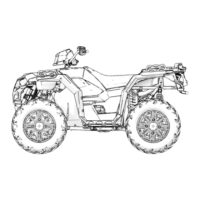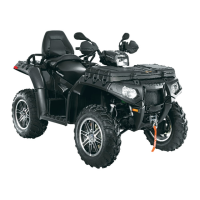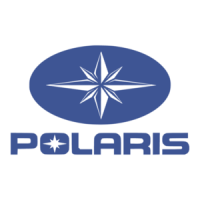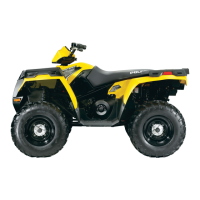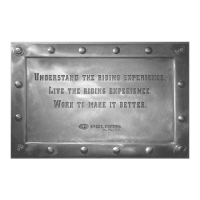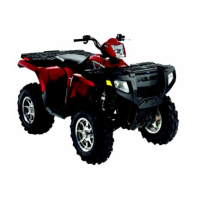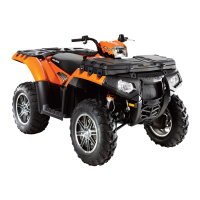
 Loading...
Loading...
Do you have a question about the Polaris Sportsman 850 and is the answer not in the manual?
| Brand | Polaris |
|---|---|
| Model | Sportsman 850 |
| Category | Offroad Vehicle |
| Language | English |
Locate and record your vehicle's identification numbers and key number.
POLARIS strongly encourages riders to take an ATV safety training course.
Always wear appropriate clothing, helmet, and eye protection for comfort and safety.
Avoid modifications that increase speed or power to maintain warranty and handling.
Key warnings and precautions for safe ATV operation, covering various scenarios.
Details and locations of important warning and information labels on the vehicle.
Explanation and operation of various vehicle switches like Mode/Reverse, 4X4, Ignition, and Headlight.
Details on the throttle lever operation, safety features, and maintenance.
How to operate the brake lever and checks for proper function and fluid level.
Checks and maintenance procedures for the master cylinder and brake fluid level.
Instructions for locking and releasing the parking brake and its safe use.
Information on refueling, fuel type, and capacity limits.
Operation and safety precautions for the auxiliary foot brake system.
Explanation of gear selector positions (H, L, N, R, P) and shifting procedures.
Tips for extending the life of the drive belt.
Overview of components located in the front compartment, including battery and fluids.
Information on the engagement and operation of the Electronic Power Steering system.
Instructions for using and securing beverages in the holders.
Explanation of the 4X4 switch and modes: ADC 4X4, 4X4, and 2X4.
Details on engaging and disengaging the Active Descent Control system.
Overview of the instrument cluster, including speedometer and indicator lamps.
Procedure for retrieving and understanding engine error codes displayed on the instrument cluster.
Definitions of diagnostic codes related to various vehicle components and systems.
Guidelines for the initial 20-hour break-in period for the engine and drivetrain.
A comprehensive checklist of items to inspect before operating the ATV.
Essential practices for safe operation, including training, age limits, and general conduct.
Practices for responsible trail riding, including safe distances and communication.
Step-by-step instructions for starting the engine, including safety interlocks.
Step-by-step guide for mounting, starting, and beginning to drive the vehicle.
Techniques and precautions for turning the vehicle smoothly and safely.
Guidelines and safety precautions for operating the ATV with a passenger.
Precautions for riding on wet, loose, or freezing surfaces to maintain traction.
Precautions and techniques for safely climbing hills, including incline limits.
Information and precautions for driving on sidehills, which is generally not recommended.
Precautions and techniques for safely descending hills, including incline limits.
Procedure for safely turning the vehicle around on a hill if it stalls.
Procedures and precautions for operating the ATV through water up to the footrest level.
Precautions for operating over obstacles, including checking terrain and avoiding large objects.
Precautions for operating the ATV in reverse, including checking surroundings and avoiding sharp angles.
Precautions for parking the vehicle on inclines, including stopping the engine and blocking wheels.
Precautions for hauling cargo, including weight limits, distribution, and securing loads.
Essential safety warnings and precautions for operating the vehicle's winch.
Step-by-step instructions and tips for safely operating the vehicle's winch.
Explanation of shock loading hazards and how to avoid them during winch operations.
Safety procedures and recommendations for winch maintenance and servicing.
Guidelines on not modifying engine components to comply with noise regulations.
A detailed chart outlining maintenance intervals for various vehicle components.
Information on recommended lubricants, capacities, and torques for various components.
Recommendations for engine oil type, checking oil level, and oil and filter change procedures.
Procedures for checking and changing transmission oil, including fluid level and capacity.
Procedures for checking and changing front gearcase fluid, including extreme use conditions.
Procedures for checking and changing rear gearcase oil, including fluid level and capacity.
Maintenance recommendation for cleaning the power steering unit for proper cooling.
Recommendation to check steering assembly for loose nuts and bolts.
Information on the engine coolant level, recovery system, and recommended antifreeze.
Checks and maintenance for the hand brake system, including fluid levels and pad wear.
Procedure to check vehicle toe alignment and recommended specifications.
Steps for removing side panels and footwells for access to vehicle components.
Instructions for removing the operator seat on 1-Up models.
Instructions for removing the operator and passenger seats on Touring models.
Information on tire tread depth, front wheel hub tightening, and wheel removal.
Steps for removing, cleaning, and reinstalling the air filter and pre-filter.
Procedure for identifying and replacing blown fuses to resolve electrical issues.
Information on headlight and taillight maintenance, including lamp replacement.
Recommendations, inspection, and replacement procedures for spark plugs.
Procedures for inspecting and servicing the vehicle after immersion in water.
Procedure for periodically purging accumulated carbon from the exhaust pipe/muffler.
Information on PVT system safety, maintenance, and operation with low/high range.
Battery removal, installation, charging, and storage procedures.
Procedure for adjusting handlebars for rider preference and proper torquing.
Procedure for adjusting throttle cable freeplay to ensure proper idle speed and throttle response.
Guidelines for washing, polishing, and storing the vehicle to maintain its condition.
Information on auxiliary power outlets and approved accessories for the ATV.
Procedures for safely securing and transporting the vehicle on a trailer or truck.
Common causes and solutions for drive belt wear, burning, and slippage.
Troubleshooting steps for when the engine does not crank or turn over.
Troubleshooting steps for when the engine cranks but does not start.
Possible causes and solutions for the engine backfiring.
Causes and solutions for engine pinging or knocking sounds.
Troubleshooting for irregular engine running, stalling, or misfiring.
Troubleshooting steps for when the engine stops or loses power during operation.
Causes and solutions for engine overheating, including radiator and screen issues.
List of recommended engine lubricants and their part numbers.
Technical specifications for the Sportsman 850 and 850 SP models.
Clutch specifications including altitude, shift weight, and spring details.
Technical specifications for the Sportsman Touring 850 SP model.
Technical specifications for the Sportsman XP 1000 model.
Technical specifications for the Sportsman XP Touring 1000 model.
Details of the six-month limited warranty on all vehicle components.
Exclusions from warranty coverage, including defects, damage, and improper use.
Instructions on how to obtain warranty service, including dealer requirements and international considerations.
Important notice regarding warranty coverage for products registered outside the purchase country.
Information on the emissions limited warranty, its duration, and covered components.
A log for recording vehicle maintenance dates, technician, and services performed.
